HubSpot is a software platform that provides tools for inbound marketing, sales, customer service, and CRM (Customer Relationship Management).
OvalEdge enables connectivity to HubSpot using the APIs, allowing for tasks such as crawling database objects and profiling sample data.
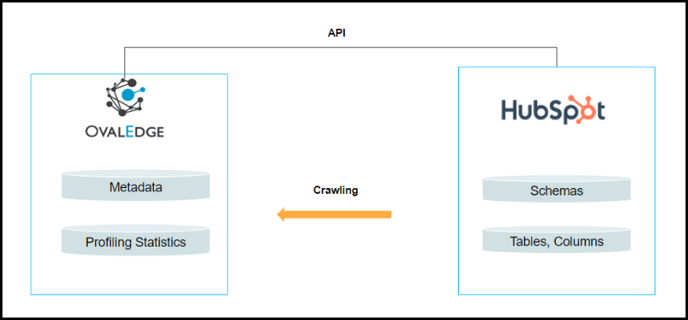
Connector Capabilities
The connector capabilities are shown below:
Crawling
| Feature | Supported Objects | Remarks |
| Crawling | Tables | |
| Table Columns |
Note: This Hubspot connector currently supports crawling & profiling for the following objects only.
- Companies
- Contacts
- Deals
- Products
- Tickets
Profiling
| Feature | Supported Objects | Remarks |
|
Table Profiling |
Row Count, Columns Count, View Sample data |
- |
|
Column Profiling |
Min, Max, Null Count, Distinct, Top 50 values |
- |
|
Full Profiling |
Not Supported |
- |
|
Sample Profiling |
Supported |
- |
Prerequisites
The following are prerequisites for connecting to the HubSpot:
Drivers
The APIs/drivers used by the connector are given below:
|
Sl.No |
Driver / API |
Version |
Details |
|---|---|---|---|
|
1 |
API |
v1,v2,v3 |
https://developers.hubspot.com/docs/api/crm/ |
Configuring Environment Variables
Configuring environment names enables you to select the appropriate environment from the drop-down list when adding a connector. This allows for consistent crawling of schemas across different environments, such as production (PROD), staging (STG), or temporary environments. It also facilitates schema comparisons and assists in application upgrades by providing a temporary environment that can later be deleted.
Before establishing a connection, it is important to configure the environment names for the specific connector. If your environments have been configured, skip this step.
Steps to Configure the Environment
- Log into the OvalEdge application.
- Navigate to Administration > System Settings.
- Select the Connector tab.
- Find the key name “connector.environment”.
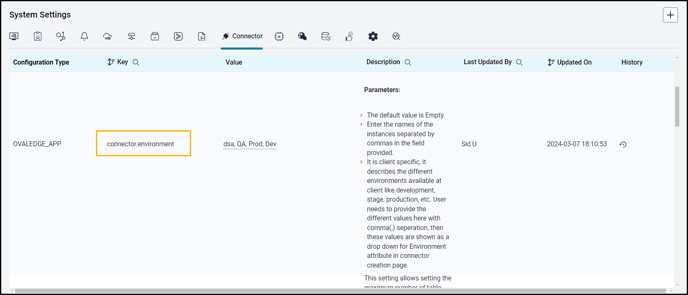
- Enter the desired environment values (PROD, STG) in the Value column.
- Click ✔ to Save.
Service Account Permissions
A service account is necessary for crawling. The minimum privileges required are:
|
Operation |
Access Permission |
|---|---|
|
Connection validate |
crm.objects.contacts.read |
|
Crawl objects |
crm.objects.contacts.read, crm.objects.deals.read, crm.schemas.companies.read, crm.schemas.contacts.read, crm.objects.owners.read, crm.schemas.deals.read, crm.objects.marketing_events.read, actions, e-commerce, tickets |
Establish a Connection
To connect to HubSpot using the OvalEdge application, complete the following steps:
- Log in to the OvalEdge application.
- Navigate to Administration > Connectors.
- Click on the + (New Connector) icon.
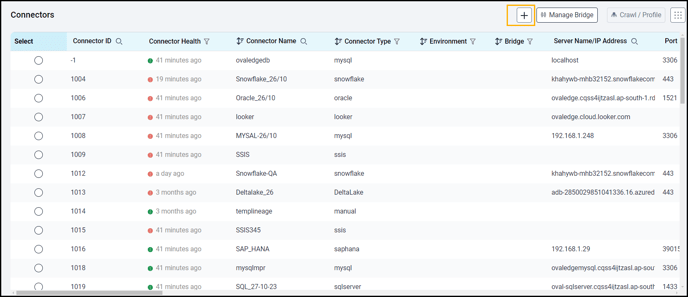
- The Add Connector pop-up window is displayed, and you can search for the HubSpot connector.

- The Add Connector with Connector Type specific details pop-up window is displayed. Enter the relevant information to configure the HubSpot connection.
Note: An asterisk (*) denotes a mandatory field for establishing a connection.
Field Name
Description Connector Type This field allows you to select the connector from the drop-down list provided. By default, 'HubSpot' is displayed as the selected connector type. Credential Manager* Select the option from the drop-down menu where you want to save your credentials:
OE Credential Manager: HubSpot connection is configured with the basic Username and Password of the service account in real-time when OvalEdge establishes a connection to the HubSpot database. Users must manually add the credentials if the OE Credential Manager option is selected.
HashiCorp: The credentials are stored in the HashiCorp database server and fetched from HashiCorp to OvalEdge.
AWS Secrets Manager: The credentials are stored in the AWS Secrets Manager database server and fetched from the AWS Secrets Manager to OvalEdge.
For more information on Azure Key Vault, refer to Azure Key Vault
For more information on Credential Manager, refer to Credential Manager
Credential Manager ConnId Enter the Credential Manager ConnId. License Add Ons All the connectors will have a Base Connector License by default that allows you to crawl and profile to obtain the metadata and statistical information from a data source.
OvalEdge supports various License Add-Ons based on the connector’s functionality requirements.
Data Quality: Select the Data Quality Add-On license to identify, report, and resolve the data quality issues for a connector whose data supports data quality, using DQ Rules/functions, Anomaly detection, Reports, and more.Connector Name* Provide a connector name for the HubSpot database in OvalEdge. This name will serve as a reference to identify the specific HubSpot database connection.
Example: "HubSpot_Connection_test"Connector Environment The Connector Environment drop-down-list allows you to select the environment configured for the connector from the drop-down list.
For example, you can select PROD or STG (based on the items configured in the OvalEdge configuration for the connector environment).
The purpose of the environment field is to help you identify which connector is connecting what type of system environment (Production, STG, or QA).
Note: The Configuring Environment Variables section explains setting up environment variables.
Hubspot API Key* A valid API key to connect with HubSpot and perform API calls.
Plugin Server Enter the server name if you are running this as a plugin.
Plugin Port Enter the port number on which the plugin is running.
Steward* Select the Steward from the drop-down list options.
Custodian* Select the Custodian from the drop-down list options.
Owner* Select the Owner from the drop-down list options.
Governance Roles 4, 5, 6* Select the respective user from the drop-down options.
Note: The drop-down list displays all the configurable roles (single user or a team) as per the configurations made in the OvalEdge Security > Governance Roles section.
Integration Admins* To add Integration Admin Roles, search for or select one or more roles from the Integration Admin options, then click the Apply button.
The responsibilities of the Integration Admin include configuring crawling and profiling settings for the connector and deleting connectors, schemas, or data objects.Security and Governance Admins* To add Security and Governance Admin roles, search for or select one or more roles from the list and then click on the Apply button.
The Security and Governance Admin is responsible for:- Configuring role permissions for the connector and its associated data objects.
- Adding admins to set permissions for the connector's roles and associated data objects.
- Updating governance roles.
- Creating custom fields.
- Developing Service Request templates for the connector.
- Creating approval workflows for Service Request templates.
No. of Archive Objects* The number of archive objects indicates the number of recent metadata modifications made to a dataset at a remote/source location. By default, the archive objects feature is deactivated. However, users may enable it by clicking the Archive toggle button and specifying the number of objects they wish to archive.
Select Bridge* With the OvalEdge Bridge component; any cloud-hosted server can connect with any on-premise or public cloud data source(s) without modifying firewall rules. A bridge provides real-time control, making managing data movement between source and destination easy. For more information, refer to
- After entering all the required connection details, select the appropriate option based on your preferences:
- Validate: Click the Validate button to verify the connection details. This ensures that the provided information is accurate and enables successful connection establishment.
- Save: Click on the Save button to store the connection details. Once saved, the connection will be added to the Connectors home page for easy access.
- Save & Configure: For certain Connectors requiring additional configuration settings, click the Save & Configure button. This will open the Connection Settings pop-up window, allowing you to configure the necessary settings before saving the connection.
- Once the connection is validated and saved, it will be displayed on the Connectors home page.
Note: You can either save the connection details first or validate the connection first and then save it.
Connection Validation Details
|
S.No |
Error Message(s) |
Description |
|
1 |
Authentication error |
When a wrong API Key is given |
Note: If you have issues creating a connection, please contact your assigned OvalEdge Customer Success Management (CSM) team.
Connector Settings
Once the connection is successfully established, various settings are provided to fetch and analyze the information from the data source.
The connection settings include Crawler, Profiler, Access Instruction, Business Glossary Settings, and Anomaly Detection Settings.
To view the Connector Settings page,
- Go to the Connectors page.
- From the 9- dots, select the Settings option.
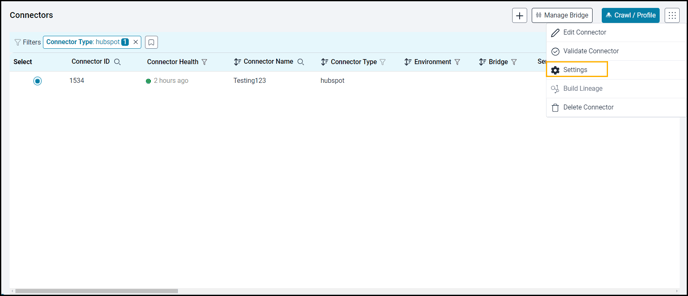
- This will display the Connector Settings page, where you can view all the connector settings.
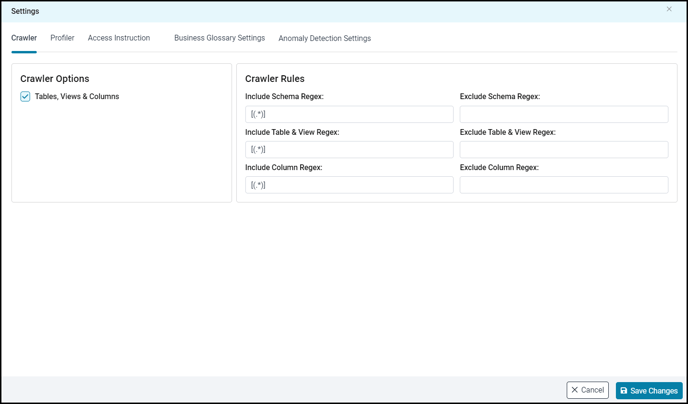
- When you have finished making your desired changes, click on Save Changes. All setting changes will be applied to the metadata.
The following is a list of connection settings, along with their corresponding descriptions.
Connection Settings
Description
Crawler
Crawler settings are configured to connect to a data source and collect and catalog all the data elements in the form of metadata.
Profiler
Profiler settings govern the process of gathering statistics and informative summaries about the connected data source(s). These statistics can help assess the quality of data sources before using them for analysis. Profiling is always optional; crawling can be run without profiling.
Access Instruction
Access Instruction allows the data owner to instruct others on using the objects in the application.
Business Glossary Settings
The Business Glossary Settings provide flexibility and control over how users view and manage term association within a business glossary at the connector level.
Anomaly Detection Settings
Anomaly Detection Settings enable users to configure anomaly detection preferences at the connector level. By default, the configuration aligns with global settings set in System Settings and cannot be modified.
Users can activate or deactivate anomaly detection for a specific connector in custom settings. They can also switch between the default Deviation or IQR algorithm and adjust associated parameters.
Crawling of Schema(s)
The Crawl/Profile option allows you to select the schema for the following operations:
Crawl, Crawl & Profile, Profile, or Profile Unprofiled. For any scheduled crawlers and profilers, the defined run date and time are displayed to set, which is under the Action section.
- Navigate to the Connectors page and click on the Crawl/Profile button.
Select Schema For Crawling and Profiling pop-up window is displayed.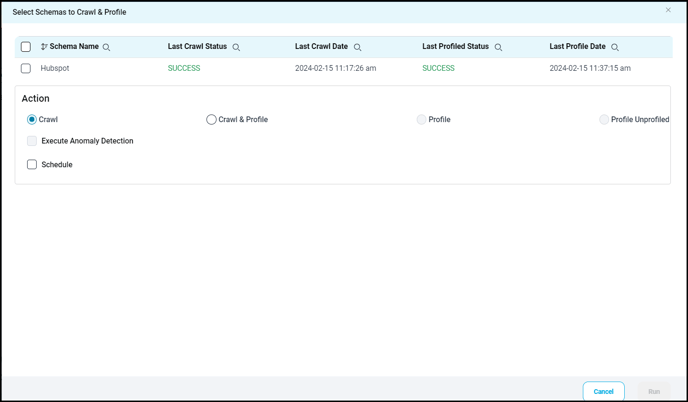
- Select the HubSpot schema.
Note: By default, a HubSpot schema is created, allowing users to choose and initiate the crawl operation. - The list of actions below is displayed in the Action section.
- Crawl: This allows the selected schema(s) metadata to be crawled.
- Crawl & Profile: This allows the metadata of the selected schema(s) and profiles of the sample data to be crawled.
- Profile: This allows the collection of table column statistics.
- Profile Unprofiled: This allows the profiling of data that has not been profiled.
- Schedule: Connectors can also be scheduled for crawling and/or profiling in advance to run at prescribed times and selected intervals.
Note: For more information on Scheduling, refer to Scheduling Connector.
- Click on the Run button. This gathers all metadata from the connected source into the OvalEdge Data Catalog.